Unit 2 School life Listening&MorePractice课件(共48张PPT)
文档属性
| 名称 | Unit 2 School life Listening&MorePractice课件(共48张PPT) |
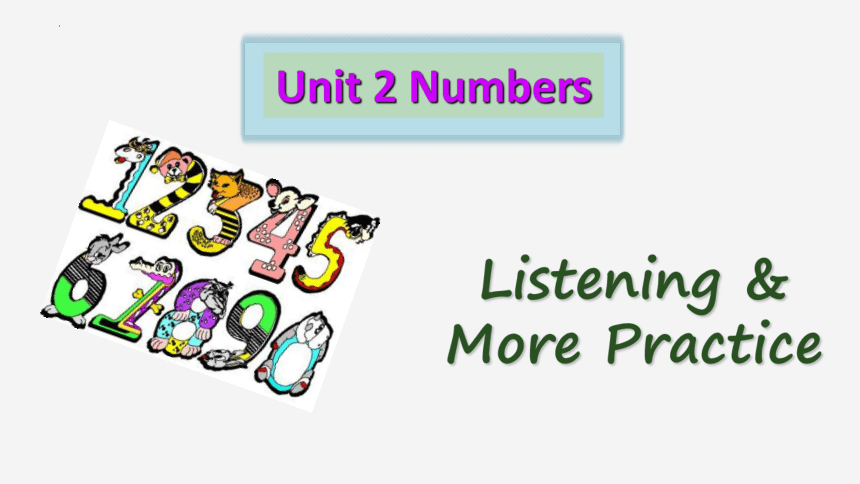
|
|
| 格式 | pptx | ||
| 文件大小 | 23.2MB | ||
| 资源类型 | 教案 | ||
| 版本资源 | 牛津译林版 | ||
| 科目 | 英语 | ||
| 更新时间 | 2023-10-08 21:39:40 | ||
图片预览

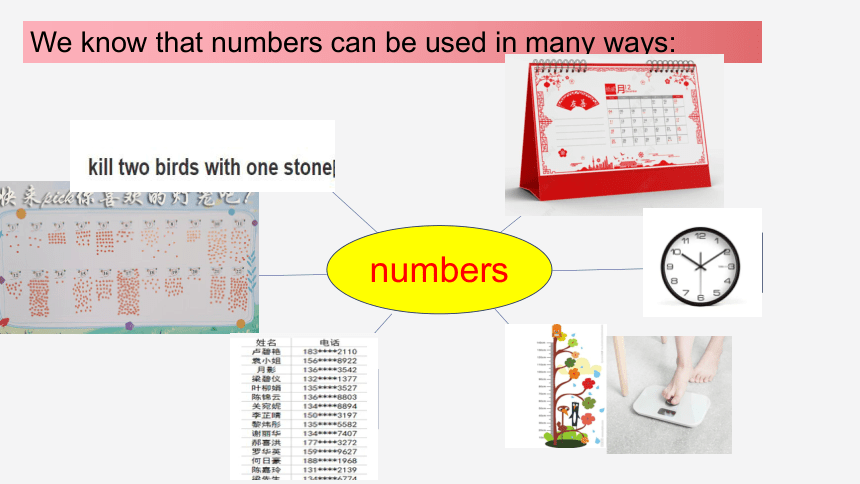
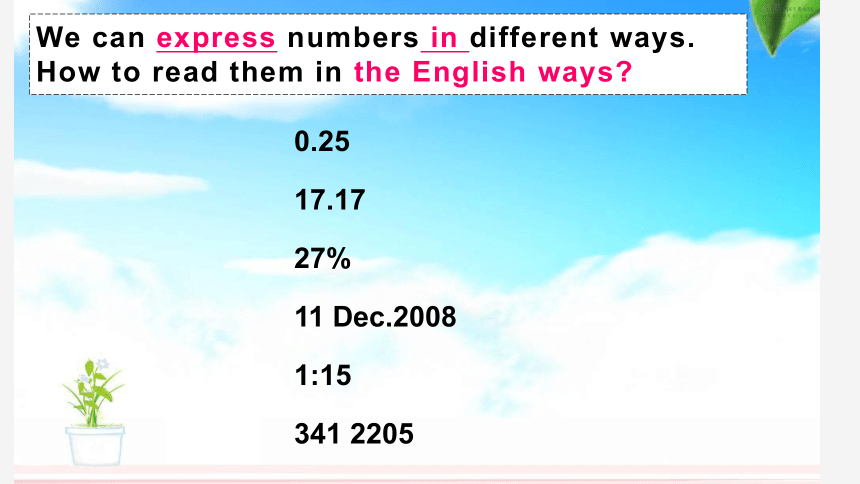
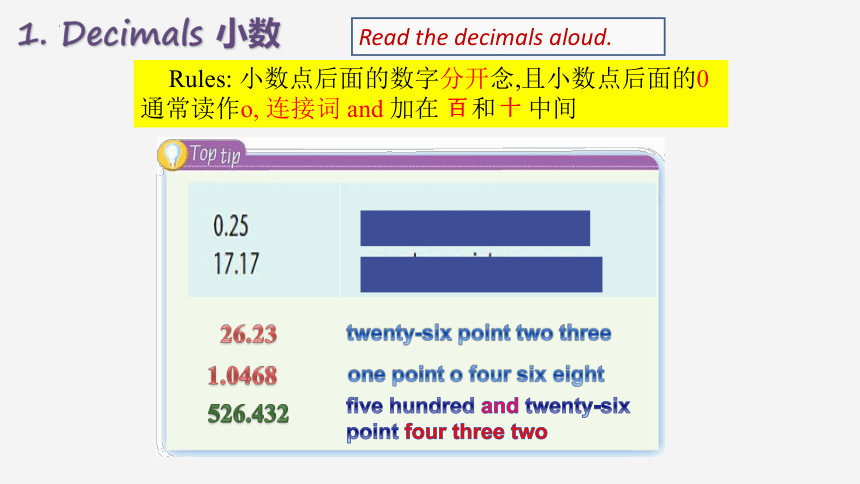
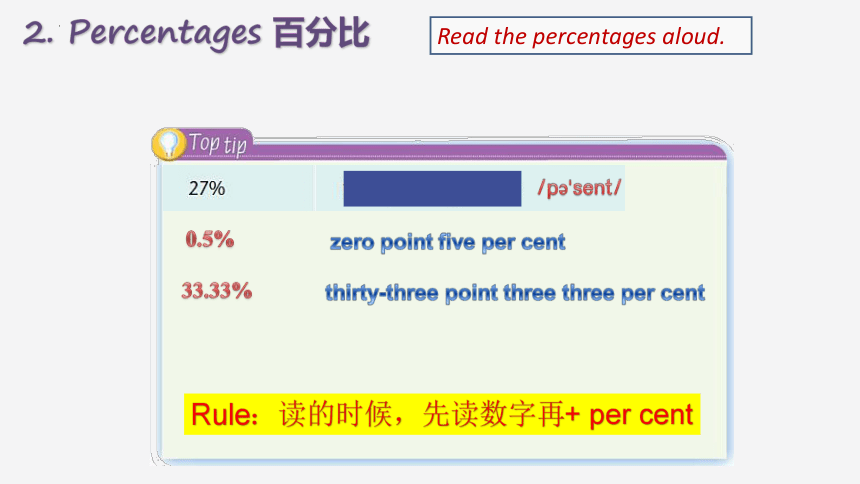
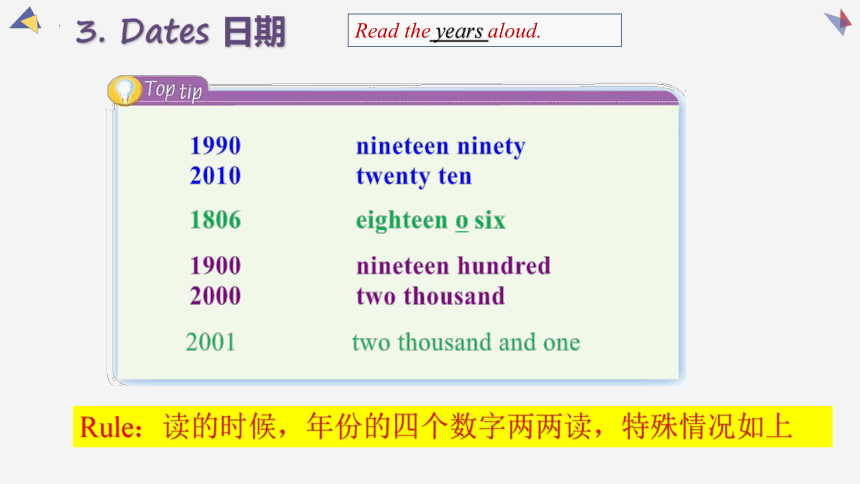
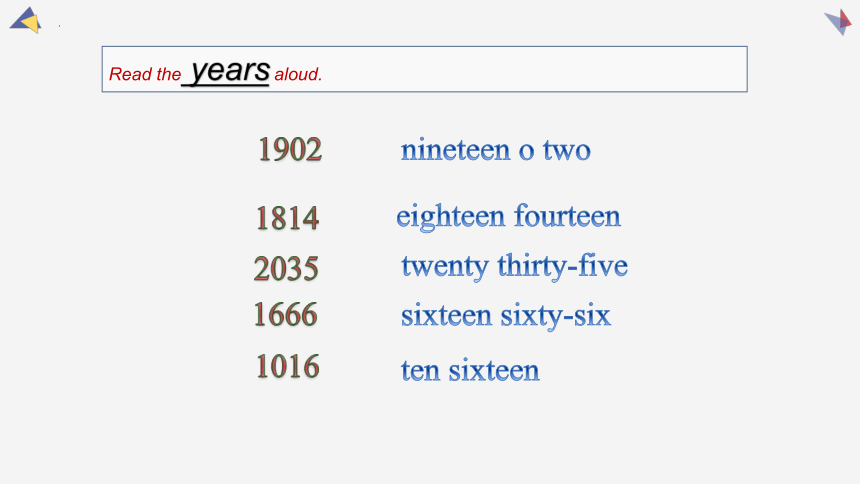
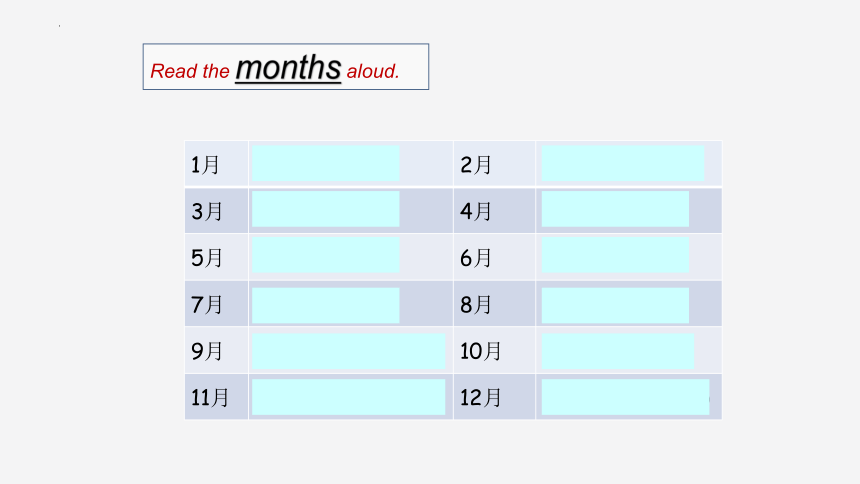
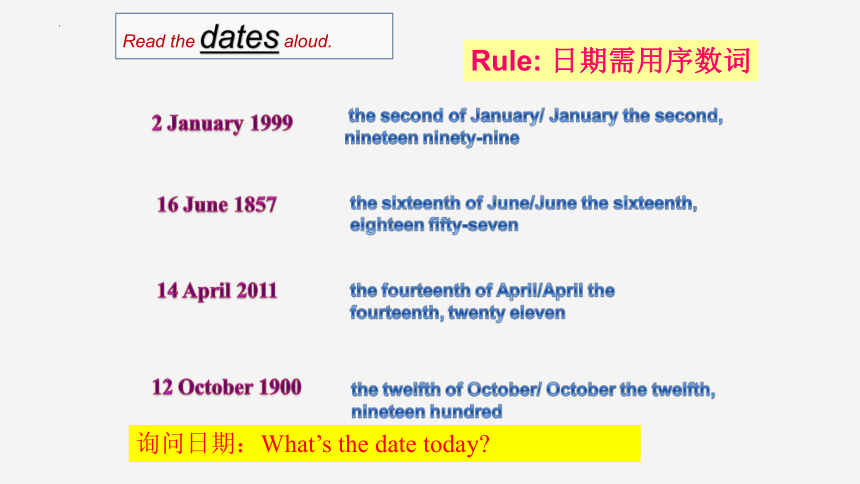
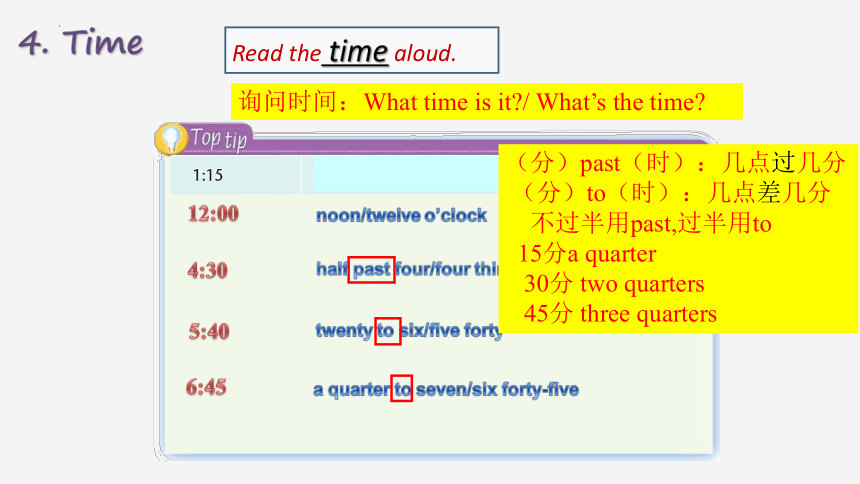
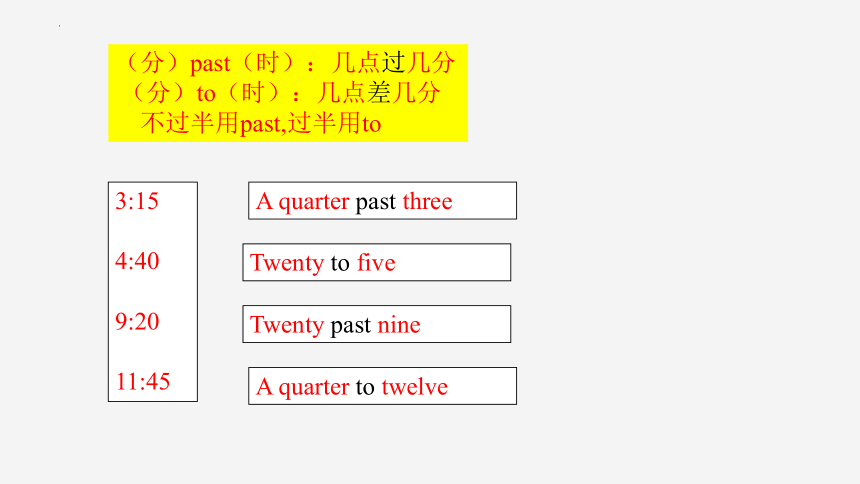
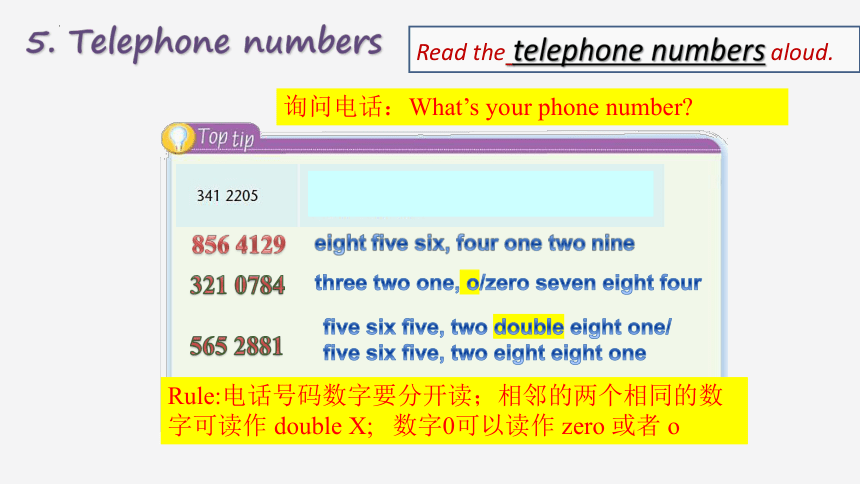
文档简介
(共48张PPT)
Listening & More Practice
Unit 2 Numbers
We know that numbers can be used in many ways:
numbers
date
time
height/weight
phone
number
order
sayings
We can express numbers in different ways. How to read them in the English ways
0.25
17.17
27%
11 Dec.2008
1:15
341 2205
1. Decimals 小数
Read the decimals aloud.
Rules: 小数点后面的数字分开念,且小数点后面的0通常读作o, 连接词 and 加在 和 中间
百
十
526.432
five hundred and twenty-six point four three two
2. Percentages 百分比
Read the percentages aloud.
Rule:读的时候,先读数字再+ per cent
3. Dates 日期
1990 nineteen ninety
2010 twenty ten
1806 eighteen o six
1900 nineteen hundred
2000 two thousand
Read the years aloud.
2001 two thousand and one
Rule:读的时候,年份的四个数字两两读,特殊情况如上
Read the years aloud.
ten sixteen
1902
1814
2035
1666
1016
nineteen o two
eighteen fourteen
twenty thirty-five
sixteen sixty-six
1月 January (Jan.) 2月 February (Feb.)
3月 March (Mar.) 4月 April (Apr.)
5月 May 6月 June
7月 July 8月 August (Aug.)
9月 September (Sept.) 10月 October (Oct.)
11月 November (Nov.) 12月 December (Dec.)
Read the months aloud.
Rule: 日期需用序数词
Read the dates aloud.
询问日期:What’s the date today
4. Time
Read the time aloud.
询问时间:What time is it / What’s the time
(分)past(时):几点过几分
(分)to(时):几点差几分
不过半用past,过半用to
15分a quarter
30分 two quarters
45分 three quarters
(分)past(时):几点过几分
(分)to(时):几点差几分
不过半用past,过半用to
3:15
4:40
9:20
11:45
A quarter past three
Twenty to five
Twenty past nine
A quarter to twelve
5. Telephone numbers
Read the telephone numbers aloud.
Rule:电话号码数字要分开读;相邻的两个相同的数字可读作 double X; 数字0可以读作 zero 或者 o
321 0784
565 2881
three two one, o/zero seven eight four
five six five, two double eight one/
five six five, two eight eight one
询问电话:What’s your phone number
6. Fractions 分数
Read the fractions aloud.
2/3
two/ thirds
Rule: 分子用基数词,分母用序数词,
分子大于1时,分母用复数形式。
1/5
one/ fifth
1/2
a/one half
1 a 65 2 a 12:13 3 a 11 October
b36 b 12:30 b 10 November
c 33 c 12:40 c 11 November
4 a 565 3881 5 a 165.5cm 6 a ¥4,700
b566 2881 b 135cm b ¥7,400
c 562 2881 c 116.5cm c ¥4,070
7 a 11% 8 a 33
b31% b 22
c 21% c 32
Listen to a quiz about numbers and circle the correct answers.
1. 30% of the students are from HK.
30% of the land is polluted.
2. A half of the students are girls.
百分比或者分数修饰名词作主语,
谓语动词跟名词一致。
More Practice
3.Three Fourths of the apple _________ rotten 坏了. It’s smelly.
A. are B. were C. was D. is
4.—What time is it now
—It’s __________.
A. ten thirty B. half pass nine
C. seven tenth D. a quarter after one
5.The man will be given _________ pay if he wants to work on Sundays.
A. two B. second C. double D. both
6. —What_____________today
—It’s the twenty-sixth of December.
A. day is it B. date it is
C. is the day D. is the date
__________of the students would like to play
computer games at weekend.
A. One fourths B. Five sixths
C. Three fourth D. Second threes
问星期: What day is it today
问日期: What is the date today
More Practice
What do these pictures refer to
Step 1:warming -up
numbers
abacus
If there are no written numbers , how can we count things
tokens made from clay or small stones
Step 2:brainstorming
fingers and toes
陶筹
marks on sticks and bones
clay /klei/
黏土
sticks
木棍/树枝
陶筹
clay /klei/
黏土
Step 3:Read for structure and genre
first
second
next
before/ after
logical
connectors
(逻辑连接词)
The article tells us ____ ways to count.
4
General
Specific
Read the title, the first paragraph,
and look at the pictures.
This article is ____________.
an exposition (说明文)
an argumentation (议论文)
a narration (记叙文)
A
This article mainly talks about the ____________ of counting methods.
difference
development
design
Step 4:skimming
Scan the article and then complete the flow chart about the development of counting methods.
their fingers and even their toes
small marks on sticks and bones
tokens made from clay or small stones
systems of written marks
the Hindu–Arabic system
Step 5:scanning
P29
Step 6:Intensive reading
could count
At first
small numbers
used
fingers and toes
At first, people used their fingers, and even their toes. However, they could only count small numbers in this way.
How
Disadvantage
Step 6:Intensive reading
After that, they began to make small marks on sticks and bones. This helped them count bigger numbers. They used them to count things like the days of the month, the amount of food and the number of animals they had.
After that
began to
make
marks on sticks and bones
helped…
count
bigger numbers
like
the days of the month
the amount of food
the number of animals
How
Advantage
What to count
Think: What are the disadvantages of counting by using sticks and bones
Step 6:Intensive reading
Then people began to use tokens made from clay or small stones. This helped them count even bigger numbers. They often put the tokens on pieces of string so that they could carry them around easily. This developed into tools like the abacus.
Then
began to
use
to count
even bigger numbers
put…on…
developed into
tokens made from clay or small stones
tools
How
Advantages
Advantages
陶筹
clay /klei/
黏土
Step 6:Intensive reading
Finally, people began to develop systems of written marks to show different numbers, and this led to the Hindu-Arabic system (0-9). We are still using this system today.
Finally
began to
develop
to show
different numbers
led to
systems of written marks
Hindu-Arabic system
How
Advantage
Step 6:Intensive reading
Finally, people began to develop systems of written marks to show different numbers, and this led to the Hindu-Arabic system (0-9). We are still using this system today.
The Indians: invented
The Arabians: took them to different places
Summary
How:
small marks on sticks/ bones
Advantage
count bigger numbers
days of the month, food, animals
What
How:
clay/ stone tokens; abacuses
Advantages
count even bigger numbers; carry around easily
How:
systems of written marks
show different numbers
Advantage
Disadvantage
only count small numbers(1-20)
How:
fingers & toes
Step 7:Intensive reading
However, they could only count small numbers in this way.
This helped them count bigger numbers.
This helped them count even bigger numbers.
Using their fingers and even their toes
Making small marks on sticks and bones
Using tokens made from clay or small stones
What does this refer to
Step7:Intensive reading
This developed into tools like the abacus.
… and this led to the Hindu-Arabic system (0~9).
We are still using this system today.
Putting the tokens on pieces of string
Developing systems of written marks
The Hindu-Arabic system
What does this refer to
This often refers to something mentioned before.
Things people used What to count Examples
Step 8:Retell
Finally,
development
more and more advanced
At first,
Then,
After that,
Step 9:Further-thinking
different numbers
for example
Step 10:Creative story-making
…
Choose some of the pictures below and then try to make a short story.
Step 10:Creative story-making
a 10-year-old boy
135 cm tall
On October 21, 2019
his ninth birthday
unforgettable
got up at 7:00 in the morning
cost 49.99 yuan
fifty percent off
watched the football match
France won by 3-2
saw strong smoke coming out
called 119
the fire was put out
At first,
After that,
Then,
Finally,
Phrases
use…to do…
以这种方式
help sb. do
…的数量
even + adj.比较级
随身携带
以便+目的从句
导致,引领
由…制成
发展成为
1. However, they could only count small numbers in this way.
in this way 以这种方式
in one’s way 挡住某人的路
on one’s way to 在去...的路上
by the way 顺便说
1. Let's wait a few moments. He's .
2. He worked very hard everyday.
,he won the first prize.
3. ---Jack, is Kate in the room
---No. , she told me she would be back soon.
4. I can’t walk across the street because a truck
is .
Language points
on his way
In this way
By the way
in my way
2.They used them to count things like the days of the month, the amount of food and the number of animals they had.
the amount of和the number of 都表示...的数量
the amount of修饰不可数名词
the number of 修饰可数名词
The number of students in Class 5 is 44.
The amount of water is decreasing.
the number of + 复数名词 + 单数动词(...的数量)
a number of + 复数名词+复数动词(很多的/大量的)
谓语动词都用单数!!!
Review
3. They often put the tokens on pieces of string
so that they could carry them around.
She gets up early _________ she won't be late for school.
so....that 如此...以至于+结果状语从句
The bag is _______ heavy______ nobody can carry it.
so that
so that
so that 以便+目的状语从句
4. They often put the tokens on pieces of string
so that they could carry them around.
carry sth around
take sth with sb 随身携带
天热,带上你的水杯。
It is hot. Carry your water bottle around.
It is hot. Take your water bottle with you.
5. This developed into tools like the abacus.
develop into 发展成为
Guangzhou has ______________ a modern city.
developed “发达的”,
developing “发展中的”
development n. 发展
developed into
6. Finally, people began to develop systems of written marks to show different numbers, and this led to the Hindu-Arabic system.
最后,人们开始开发书写标记的方法来表示不同的数字,而这通向了印度阿拉伯系统。
(1)system “系统;制度;方法”
(2) lead to “引起,导致,通向…的路”。
lead 过去式是led;
lead sb. to…“把某人带领到...”。
Exercise
1. At weekends, I usually help my mum ________ some housework.
A. to doing B. do
C. does D. for doing
2. I have many hobbies________ singing, playing chess and so on.
A. are like B. like
C. for example D. look likes
3. The old farmer are counting ________ money and _________ animals he had.
A. the amount of; the number of
B. the amount of; the amount of
C. the number of; the amount of
D. the number of; the number of
4. 吃完晚饭后,他开始做作业了。
After dinner, he ______ ________ _______ his homework.
5. 《中国好声音》以这种方式吸引越来越多的观众。
Voice of China attracts more and more audience _______ ____________.
6. 他这次小小的错误引起了巨大的损失。
His mistake _______ ________ a big loss this time.
began/started to do
this way
led to
in
Numbers around the world
People around the world write numbers in different ways. The following shows how people from different cultures write one to five.
Chinese: 一、二、三、四、五
Romans: I, II, III, IV, V
English: one, two, three, four, five
However, most people around the
world use Arabic numbers
(1, 2, 3, 4, 5, etc.) today.
Culture corner
Romans
Chinese
English
Arabic numbers
Numbers
around
the world
Look at the picture and read the article. Then make a spidergram about the numbers around the world.
THANKS
Listening & More Practice
Unit 2 Numbers
We know that numbers can be used in many ways:
numbers
date
time
height/weight
phone
number
order
sayings
We can express numbers in different ways. How to read them in the English ways
0.25
17.17
27%
11 Dec.2008
1:15
341 2205
1. Decimals 小数
Read the decimals aloud.
Rules: 小数点后面的数字分开念,且小数点后面的0通常读作o, 连接词 and 加在 和 中间
百
十
526.432
five hundred and twenty-six point four three two
2. Percentages 百分比
Read the percentages aloud.
Rule:读的时候,先读数字再+ per cent
3. Dates 日期
1990 nineteen ninety
2010 twenty ten
1806 eighteen o six
1900 nineteen hundred
2000 two thousand
Read the years aloud.
2001 two thousand and one
Rule:读的时候,年份的四个数字两两读,特殊情况如上
Read the years aloud.
ten sixteen
1902
1814
2035
1666
1016
nineteen o two
eighteen fourteen
twenty thirty-five
sixteen sixty-six
1月 January (Jan.) 2月 February (Feb.)
3月 March (Mar.) 4月 April (Apr.)
5月 May 6月 June
7月 July 8月 August (Aug.)
9月 September (Sept.) 10月 October (Oct.)
11月 November (Nov.) 12月 December (Dec.)
Read the months aloud.
Rule: 日期需用序数词
Read the dates aloud.
询问日期:What’s the date today
4. Time
Read the time aloud.
询问时间:What time is it / What’s the time
(分)past(时):几点过几分
(分)to(时):几点差几分
不过半用past,过半用to
15分a quarter
30分 two quarters
45分 three quarters
(分)past(时):几点过几分
(分)to(时):几点差几分
不过半用past,过半用to
3:15
4:40
9:20
11:45
A quarter past three
Twenty to five
Twenty past nine
A quarter to twelve
5. Telephone numbers
Read the telephone numbers aloud.
Rule:电话号码数字要分开读;相邻的两个相同的数字可读作 double X; 数字0可以读作 zero 或者 o
321 0784
565 2881
three two one, o/zero seven eight four
five six five, two double eight one/
five six five, two eight eight one
询问电话:What’s your phone number
6. Fractions 分数
Read the fractions aloud.
2/3
two/ thirds
Rule: 分子用基数词,分母用序数词,
分子大于1时,分母用复数形式。
1/5
one/ fifth
1/2
a/one half
1 a 65 2 a 12:13 3 a 11 October
b36 b 12:30 b 10 November
c 33 c 12:40 c 11 November
4 a 565 3881 5 a 165.5cm 6 a ¥4,700
b566 2881 b 135cm b ¥7,400
c 562 2881 c 116.5cm c ¥4,070
7 a 11% 8 a 33
b31% b 22
c 21% c 32
Listen to a quiz about numbers and circle the correct answers.
1. 30% of the students are from HK.
30% of the land is polluted.
2. A half of the students are girls.
百分比或者分数修饰名词作主语,
谓语动词跟名词一致。
More Practice
3.Three Fourths of the apple _________ rotten 坏了. It’s smelly.
A. are B. were C. was D. is
4.—What time is it now
—It’s __________.
A. ten thirty B. half pass nine
C. seven tenth D. a quarter after one
5.The man will be given _________ pay if he wants to work on Sundays.
A. two B. second C. double D. both
6. —What_____________today
—It’s the twenty-sixth of December.
A. day is it B. date it is
C. is the day D. is the date
__________of the students would like to play
computer games at weekend.
A. One fourths B. Five sixths
C. Three fourth D. Second threes
问星期: What day is it today
问日期: What is the date today
More Practice
What do these pictures refer to
Step 1:warming -up
numbers
abacus
If there are no written numbers , how can we count things
tokens made from clay or small stones
Step 2:brainstorming
fingers and toes
陶筹
marks on sticks and bones
clay /klei/
黏土
sticks
木棍/树枝
陶筹
clay /klei/
黏土
Step 3:Read for structure and genre
first
second
next
before/ after
logical
connectors
(逻辑连接词)
The article tells us ____ ways to count.
4
General
Specific
Read the title, the first paragraph,
and look at the pictures.
This article is ____________.
an exposition (说明文)
an argumentation (议论文)
a narration (记叙文)
A
This article mainly talks about the ____________ of counting methods.
difference
development
design
Step 4:skimming
Scan the article and then complete the flow chart about the development of counting methods.
their fingers and even their toes
small marks on sticks and bones
tokens made from clay or small stones
systems of written marks
the Hindu–Arabic system
Step 5:scanning
P29
Step 6:Intensive reading
could count
At first
small numbers
used
fingers and toes
At first, people used their fingers, and even their toes. However, they could only count small numbers in this way.
How
Disadvantage
Step 6:Intensive reading
After that, they began to make small marks on sticks and bones. This helped them count bigger numbers. They used them to count things like the days of the month, the amount of food and the number of animals they had.
After that
began to
make
marks on sticks and bones
helped…
count
bigger numbers
like
the days of the month
the amount of food
the number of animals
How
Advantage
What to count
Think: What are the disadvantages of counting by using sticks and bones
Step 6:Intensive reading
Then people began to use tokens made from clay or small stones. This helped them count even bigger numbers. They often put the tokens on pieces of string so that they could carry them around easily. This developed into tools like the abacus.
Then
began to
use
to count
even bigger numbers
put…on…
developed into
tokens made from clay or small stones
tools
How
Advantages
Advantages
陶筹
clay /klei/
黏土
Step 6:Intensive reading
Finally, people began to develop systems of written marks to show different numbers, and this led to the Hindu-Arabic system (0-9). We are still using this system today.
Finally
began to
develop
to show
different numbers
led to
systems of written marks
Hindu-Arabic system
How
Advantage
Step 6:Intensive reading
Finally, people began to develop systems of written marks to show different numbers, and this led to the Hindu-Arabic system (0-9). We are still using this system today.
The Indians: invented
The Arabians: took them to different places
Summary
How:
small marks on sticks/ bones
Advantage
count bigger numbers
days of the month, food, animals
What
How:
clay/ stone tokens; abacuses
Advantages
count even bigger numbers; carry around easily
How:
systems of written marks
show different numbers
Advantage
Disadvantage
only count small numbers(1-20)
How:
fingers & toes
Step 7:Intensive reading
However, they could only count small numbers in this way.
This helped them count bigger numbers.
This helped them count even bigger numbers.
Using their fingers and even their toes
Making small marks on sticks and bones
Using tokens made from clay or small stones
What does this refer to
Step7:Intensive reading
This developed into tools like the abacus.
… and this led to the Hindu-Arabic system (0~9).
We are still using this system today.
Putting the tokens on pieces of string
Developing systems of written marks
The Hindu-Arabic system
What does this refer to
This often refers to something mentioned before.
Things people used What to count Examples
Step 8:Retell
Finally,
development
more and more advanced
At first,
Then,
After that,
Step 9:Further-thinking
different numbers
for example
Step 10:Creative story-making
…
Choose some of the pictures below and then try to make a short story.
Step 10:Creative story-making
a 10-year-old boy
135 cm tall
On October 21, 2019
his ninth birthday
unforgettable
got up at 7:00 in the morning
cost 49.99 yuan
fifty percent off
watched the football match
France won by 3-2
saw strong smoke coming out
called 119
the fire was put out
At first,
After that,
Then,
Finally,
Phrases
use…to do…
以这种方式
help sb. do
…的数量
even + adj.比较级
随身携带
以便+目的从句
导致,引领
由…制成
发展成为
1. However, they could only count small numbers in this way.
in this way 以这种方式
in one’s way 挡住某人的路
on one’s way to 在去...的路上
by the way 顺便说
1. Let's wait a few moments. He's .
2. He worked very hard everyday.
,he won the first prize.
3. ---Jack, is Kate in the room
---No. , she told me she would be back soon.
4. I can’t walk across the street because a truck
is .
Language points
on his way
In this way
By the way
in my way
2.They used them to count things like the days of the month, the amount of food and the number of animals they had.
the amount of和the number of 都表示...的数量
the amount of修饰不可数名词
the number of 修饰可数名词
The number of students in Class 5 is 44.
The amount of water is decreasing.
the number of + 复数名词 + 单数动词(...的数量)
a number of + 复数名词+复数动词(很多的/大量的)
谓语动词都用单数!!!
Review
3. They often put the tokens on pieces of string
so that they could carry them around.
She gets up early _________ she won't be late for school.
so....that 如此...以至于+结果状语从句
The bag is _______ heavy______ nobody can carry it.
so that
so that
so that 以便+目的状语从句
4. They often put the tokens on pieces of string
so that they could carry them around.
carry sth around
take sth with sb 随身携带
天热,带上你的水杯。
It is hot. Carry your water bottle around.
It is hot. Take your water bottle with you.
5. This developed into tools like the abacus.
develop into 发展成为
Guangzhou has ______________ a modern city.
developed “发达的”,
developing “发展中的”
development n. 发展
developed into
6. Finally, people began to develop systems of written marks to show different numbers, and this led to the Hindu-Arabic system.
最后,人们开始开发书写标记的方法来表示不同的数字,而这通向了印度阿拉伯系统。
(1)system “系统;制度;方法”
(2) lead to “引起,导致,通向…的路”。
lead 过去式是led;
lead sb. to…“把某人带领到...”。
Exercise
1. At weekends, I usually help my mum ________ some housework.
A. to doing B. do
C. does D. for doing
2. I have many hobbies________ singing, playing chess and so on.
A. are like B. like
C. for example D. look likes
3. The old farmer are counting ________ money and _________ animals he had.
A. the amount of; the number of
B. the amount of; the amount of
C. the number of; the amount of
D. the number of; the number of
4. 吃完晚饭后,他开始做作业了。
After dinner, he ______ ________ _______ his homework.
5. 《中国好声音》以这种方式吸引越来越多的观众。
Voice of China attracts more and more audience _______ ____________.
6. 他这次小小的错误引起了巨大的损失。
His mistake _______ ________ a big loss this time.
began/started to do
this way
led to
in
Numbers around the world
People around the world write numbers in different ways. The following shows how people from different cultures write one to five.
Chinese: 一、二、三、四、五
Romans: I, II, III, IV, V
English: one, two, three, four, five
However, most people around the
world use Arabic numbers
(1, 2, 3, 4, 5, etc.) today.
Culture corner
Romans
Chinese
English
Arabic numbers
Numbers
around
the world
Look at the picture and read the article. Then make a spidergram about the numbers around the world.
THANKS
